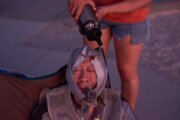The term “kidney stone” is a widely-used nickname to describe the calcifications consisting of the body’s excess minerals and salts that can build up inside the kidney. As these substances accumulate in the kidney and begin to harden, they begin to form a crystal. When multiple crystals accumulate and join together in a more compact form, we end up with a pebble-like formation called a kidney stone.
To understand how these “stones” end up in the kidney, a little bit of urinary tract background is necessary. The kidneys are part of the urinary system, and their job is to regulate the body’s fluid and chemical levels. They do this by filtering waste out of the blood and excreting it through our urine. In doing so, the kidneys are responsible for controlling the levels of sodium, potassium and calcium in the blood — all chemicals that have to maintain a proper balance, as too much or too little can throw off the body’s delicate homeostasis balance. So, when there’s too much of one of these chemical substances filtered out of the blood, it can accumulate in the kidney and develop into these hardened crystals.
[See: What Color Should My Pee Be? A Stream of Urine Questions, Answered.]
If you’ve ever known anyone who has had to endure a kidney stone, or if you’ve had one yourself, the general consensus is that they can be excruciatingly painful. I’ve even heard the pain of passing a kidney stone compared to the pain of childbirth (I have treated women who’ve experienced both and they attest to this). However, this is not always the case. In some cases of kidney stones, there is relatively no pain at all, and some patients never even know they have one. The difference in experience all depends on the location of the stone within the urinary tract.
When a stone forms, it may be as small as a grain of salt or, in rare cases, become as large as a golf ball. The size of the stone surprisingly does not have as much to do with the symptoms as does the movement of the stone. If it stays put in the kidney, sometimes a patient will not even realize it’s there, and these stones often go undiagnosed. The pain arises when the stone moves from the kidney into the ureter — the small tube that transports urine from the kidney to the bladder. If the stone blocks the passing of urine in one (or both) of these tubes, the urine will begin to back up into the bladder, causing swelling and pain, which can be accompanied by nausea and vomiting, sharp, cramping pain in the lower back and abdomen (that usually comes in waves as the body tries to rid itself of the stone) and an intense urge to urinate.
While it’s true that all kidney stones are made up of excess chemicals, we urologists break them down into different types to help pinpoint which treatment will work best.
Calcium (80 percent of stones). Contrary to what you may instinctively think, calcium stones are not typically caused by an excess intake of calcium. Rather, they’re due to an excess of calcium oxalate, a compound found in some foods, and a waste product produced by the body. High amounts of sodium, vitamin D and dehydration are also major contributors to these types of kidney stones.
Uric acid (5 to 10 percent of stones). Uric acid is a waste product of chemical reactions in the body that will not dissolve when mixed with urine that is acidic and will begin to form crystals as it builds up. Having acidic urine may be due to obesity, Type 2 diabetes, gout or a diet too high in animal protein.
Struvite (10 percent of stones). Struvite stones are made up of calcium ammonium phosphate. They are caused by recurrent kidney or urinary tract infections involving bacteria that make the urine less acidic and more basic/alkaline, and the byproducts of these bacteria form stones and grow in the alkaline urine.
Cystine (1 percent of stones). This type of stone is very rare and caused by an inherited metabolic disorder where the kidneys do not reabsorb cysteine (an amino acid) from the urine, and the high amounts remaining in the urine cause stones to form.
In most cases, kidney stones must be medically treated in order to be removed. This can include shock wave lithotripsy, a procedure where sound waves are focused from outside the body onto the stone in the kidney. This procedure aims to crack and break the stone into smaller pieces that can be passed through the ureters, into the bladder and out of the body. Laser lithotripsy works in a similar way, using a laser beam focused into the kidney through a scope to pulverize the stone. In rare circumstances, kidney stones may be chemically dissolved. Pure uric acid stones, for example, may be dissolved by decreasing the acidity or alkalinizing the urine.
In order to avoid having to undergo any of these procedures, how can we prevent kidney stones in the first place? The single best piece of advice I can give is to drink more water. A dehydrated state is a major risk factor for kidney stone formation, so staying adequately hydrated is key. My recommendation is to drink at least 3 liters of water every day; doing this will help dissolve any excess toxins or chemicals that build up before they can form into crystals or stones. Another way to reduce kidney stone risk is to consume less salt in your diet. As the body excretes sodium, it also excretes calcium, so limiting your intake will in turn reduce the amount of calcium in the urine. Eating foods with low oxalate levels and reducing intake of meat (animal protein) can also be helpful.
The recommendations for every person with kidney stones vary, and specific dietary instructions need to be individually determined by your urologist. Once it’s discovered why you’re forming stones, he or she will give you treatment options and personalized tips on how to prevent them in the future. However, as a general rule, following a balanced diet with appropriate amounts of water and maintaining a healthy weight will put you on the right path to healthy and stone-free kidneys.
More from U.S. News
On a Scale From 1 to 10: Most Painful Medical Conditions
11 Ways to Cope With Back Pain
Your Guide to Over-the-Counter Pain Relief
Hard Truths About Kidney Stones originally appeared on usnews.com







